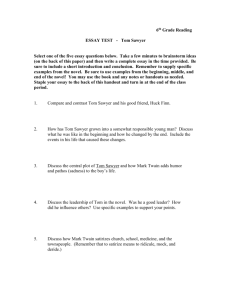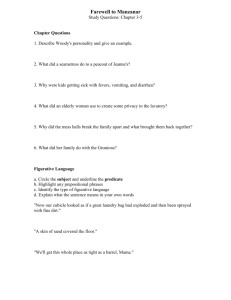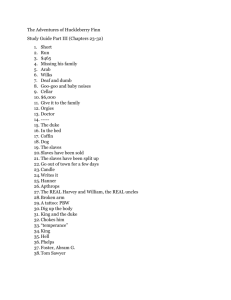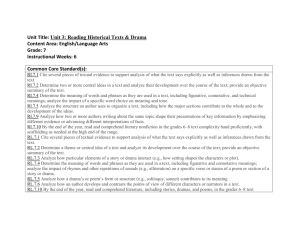6R-Unit-4-complete.doc - Inwood Intermediate School 52
advertisement
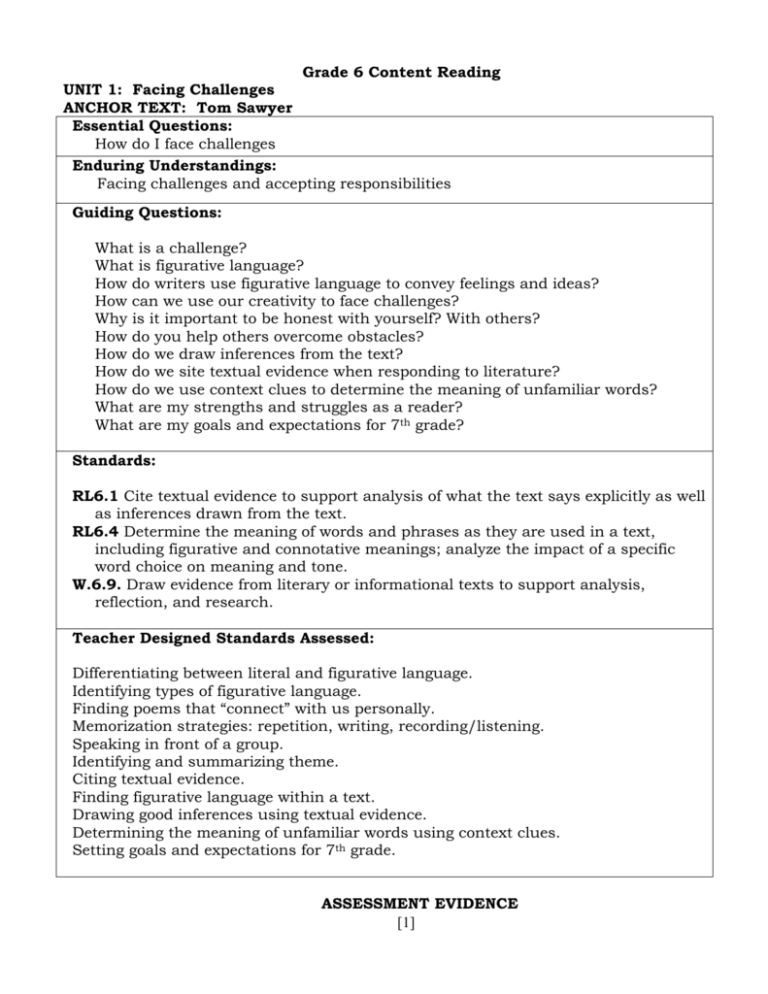
Grade 6 Content Reading UNIT 1: Facing Challenges ANCHOR TEXT: Tom Sawyer Essential Questions: How do I face challenges Enduring Understandings: Facing challenges and accepting responsibilities Guiding Questions: What is a challenge? What is figurative language? How do writers use figurative language to convey feelings and ideas? How can we use our creativity to face challenges? Why is it important to be honest with yourself? With others? How do you help others overcome obstacles? How do we draw inferences from the text? How do we site textual evidence when responding to literature? How do we use context clues to determine the meaning of unfamiliar words? What are my strengths and struggles as a reader? What are my goals and expectations for 7th grade? Standards: RL6.1 Cite textual evidence to support analysis of what the text says explicitly as well as inferences drawn from the text. RL6.4 Determine the meaning of words and phrases as they are used in a text, including figurative and connotative meanings; analyze the impact of a specific word choice on meaning and tone. W.6.9. Draw evidence from literary or informational texts to support analysis, reflection, and research. Teacher Designed Standards Assessed: Differentiating between literal and figurative language. Identifying types of figurative language. Finding poems that “connect” with us personally. Memorization strategies: repetition, writing, recording/listening. Speaking in front of a group. Identifying and summarizing theme. Citing textual evidence. Finding figurative language within a text. Drawing good inferences using textual evidence. Determining the meaning of unfamiliar words using context clues. Setting goals and expectations for 7th grade. ASSESSMENT EVIDENCE [1] Performance Task(s): Alignment to NYS Common Core Standards: Students will read and discuss the poem Mother to Son, by Langston Hughes, which illustrates the theme of challenges. Students will explain how the poet uses figurative language to convey the theme or the theme of the poem. Students will cite specific language from the text in their explanation. RL6.4 Determine the meaning of words and phrases as they are used in a text, including figurative and connotative meanings; analyze the impact of a specific word choice on meaning and tone. W.6.9. Draw evidence from literary or informational texts to support analysis, reflection, and research. Students will read and discuss Tom Sawyer. Students will state three obstacles Tom Sawyer had to overcome and the strategies he used to face these challenges. Students will cite specific evidence from the text in their explanation. RL6.1 Cite textual evidence to support analysis of what the text says explicitly as well as inferences drawn from the text. W.6.9. Draw evidence from literary or informational texts to support analysis, reflection, and research. Students will respond to literature by describing challenges they have met in life and the strategies that were used to tackle these challenges. They will make connections to the texts we have read this marking period, using specific evidence from Tom Sawyer and other biographical and nonfiction texts. Special emphasis will be placed on using figurative language. Diagnostic and Pre/Post Assessments: Students will complete learning tasks detailed below. [2] RL6.1 Cite textual evidence to support analysis of what the text says explicitly as well as inferences drawn from the text. W.6.9. Draw evidence from literary or informational texts to support analysis, reflection, and research. Formative Assessments: Students will complete performance tasks 1 and 2. Summative Assessment: Students will respond to literature by describing a challenge they have faced in life and the strategies that were used to tackle this challenges. They will make connections to the texts we have read this marking period, using specific evidence from Tom Sawyer and other biographical and nonfiction texts. Special emphasis will be placed on using figurative language. TEACHING AND LEARNING PLAN Teaching and Learning Activities: Read the text The Adventures of Tom Sawyer by Mark Twain. Reading biographical short texts: Jim Abbot, Michael Jordan, Helen Keller, Curtis Jackson. What challenges did the men and women in the biographical short texts face? How did they overcome them? What is figurative language? How do we differentiate between figurative and literal language? What makes a poem “connect” with us personally? What resources can we use to find poems that connect? Memorization strategies: repetition, writing, recording/listening. Students will write and memorize a poem and present to the class, or alternately, find a poem that is meaningful to them, memorize and present to the class. Read the poem “If” by Rudyard Kipling. Explore how the poet uses figurative language to convey his feelings and ideas about life. Write a poem using figurative language. Topics may include unit themes such as overcoming challenges and facing obstacles. Written responses to Tom Sawyer 1-20: have you ever gotten out something you didn’t want to do? How? Written response: What is the theme of the poem “If”? Discussion: How can we face challenges creatively? How did Tom Sawyer face challenges creatively? Written response: how did Tom Sawyer face challenges creatively? [3] Read the poem “Mother to Son” by Langston Hughes. Discuss: is being honest as simple as always telling the truth? Why or why not? Discuss: is Tom Sawyer an honest person? What evidence can you find in the text to support your view? Written response: do you consider yourself an honest person? Why or why not? Discuss: what are some of the obstacles we face? Who can help us overcome them? Graphic organizer: What figurative language is used in this week’s reading? (“A whole hour drifted past” [64], “He racked his brain [64], “Tom was trembling from head to toe” [65]. Students will use a graphic organizer to cite textual evidence, answering the question: “What are three obstacles Tom Sawyer has faced?” What does it mean to draw an inference? What makes a good inference? Read-aloud: what inferences can we make as we read the scene in which Tom enters the haunted house? Written response: what inference can you make about what will happen in the next chapter? Will Tom and Huck find Injun Joe? How can we determine the meaning of unfamiliar words using context clues? Active reading: students will identify unfamiliar words in the week’s reading, and use context clues to determine their meaning. Written Response: what would you do if you found a bag of gold like Tom and Huck? Written response: what are my goals and expectations for 7th grade? (Responses to be saved and presented to students at the end of 7th grade) Resources Needed: Poetry: Harriet Tubman, Eloise Greenfield If, Rudyard Kipling Books Fall Open, David McCord Annabell Lee, Edgar Allen Poe The Raven, Edgar Allen Poe Cradle Song, Alfred Lord Tennyson Alone in the Nets, Arnold Adoff [4] Simple Songs, Marge Piercy Another Mountain, Abiodun Oyewole Mother to Son, Langston Hughes Biographies: Helen Keller Michael Jordan Jim Abbott My Papa, Mark Twain Curtis Jackson 50 cent Short Stories from: Sandra Cisneros Sharon Flake [5] UNIT 4: Tom Sawyer Week 1 Standards Assessed: Week 2 WEEKLY CALENDAR Guiding Questions Topics/Lessons Assessments Key Vocabulary (diagnostic, formative, summative, interim) What is a challenge? Challenge, obstacle Reading Discussion: how the biographical short men and women in texts: Jim Abbot, the texts overcome Michael Jordan, challenges (students Helen Keller, will be informally Curtis Jackson assessed during this week through What challenges classroom discussion, did these men and as they will be taking women face? How state tests during the did they overcome same week). them? W.6.9. Draw evidence from literary or informational texts to support analysis, reflection, and research. Guiding Questions What is figurative language? Topics/Lessons What is figurative language? How do we differentiate between figurative and literal language? What makes a poem “connect” with Assessments (diagnostic, formative, summative, interim) Students will write and memorize a poem and present to the class, or alternately, find a poem that is meaningful to them, memorize and present to the class. [6] Key Vocabulary figurative, literal, imagery Standards Assessed: us personally? What resources can we use to find poems that connect? Memorizati on strategies: repetition, writing, recording/liste ning RL6.4 Determine the meaning of words and phrases as they are used in a text, including figurative and connotative meanings; analyze the impact of a specific word choice on meaning and tone. Week Guiding Questions 3 How do writers use figurative language to convey feelings and ideas? Topics/Lessons Read pages 120 Read the poem “If” by Rudyard Kipling. Explore how the poet uses figurative language to convey his feelings and ideas about life. Write a poem using figurative language. [7] Assessments (diagnostic, formative, summative, interim) Reading comprehension questions: students will demonstrate their knowledge of the main characters, setting, and key ideas introduced in chapters 1 and 2. Written responses to Tom Sawyer 120: have you ever gotten out something you didn’t want to do? How? Written response: Key Vocabulary Idiom, triumph, imposter, virtue, metaphor, simile Topics may What is the theme include unit of the poem “If”? themes such as overcoming challenges and facing obstacles. Standards RL6.4 Determine the meaning of words and phrases as they are used in a text, including figurative and Assessed: connotative meanings; analyze the impact of a specific word choice on meaning and tone. Week 4 Guiding Questions How can we use our creativity to face challenges? Topics/Lessons Read pages 21-40 Discussion: How can we face challenges creatively? How did Tom Sawyer face challenges creatively? Read the poem “Mother to Son” by Langston Hughes Performance task #1 Assessments (diagnostic, formative, summative, interim) Performance task #1 Written response: how did Tom Sawyer face challenges creatively? Key Vocabulary Sternly, drifter, dandy Standards Assessed: RL6.1 Cite textual evidence to support analysis of what the text says explicitly as well as inferences drawn from the text. Week Guiding Questions Topics/Lessons [8] Assessments (diagnostic, formative, Key Vocabulary summative, interim) Written response: do you consider yourself an honest person? Why or why not? Vocabulary weeks 1-4 review and assessment Standards Assessed: Integrity, ethical, Read pages 41candid, 60 scuffling Discuss: is being honest as simple as How do we site textual always telling evidence when the truth? Why responding to or why not? literature? Discuss: is Tom Sawyer an honest person? What evidence can you find in the text to support your view? RL6.1 Cite textual evidence to support analysis of what the text says explicitly as well as inferences drawn from the text. Week Guiding Questions Topics/Lessons 6 How do you help others overcome obstacles? Read pages 6180 Discuss: what are some of the obstacles we face? Who can help us overcome them? 5 Why is it important to be honest with yourself? With others? Assessments (diagnostic, formative, summative, interim) Students will use a graphic organizer to cite textual evidence, answering the question: “What are three obstacles Tom Sawyer has faced?” Performance task #2 Graphic organizer: What figurative language is used in this week’s reading? (“A whole hour drifted past” [64], “He [9] Key Vocabulary Engraved, denial, folly racked his brain [64], “Tom was trembling from head to toe” [65]. Standards Assessed: RL6.1 Cite textual evidence to support analysis of what the text says explicitly as well as inferences drawn from the text. RL6.4 Determine the meaning of words and phrases as they are used in a text, including figurative and connotative meanings; analyze the impact of a specific word choice on meaning and tone. Week Guiding Questions 7 Inference, reckon, Read pages 81disguise 106 What does it mean to draw an inference? What makes a good inference? Read-aloud: what inferences can we make as we read the scene in which Tom enters the haunted house? W.6.9. Draw evidence from literary or informational texts to support analysis, reflection, and research. Standards Assessed: Week Topics/Lessons How do we draw inferences from the text? Guiding Questions Topics/Lessons [10] Assessments (diagnostic, formative, summative, interim) Written response: what inference can you make about what will happen in the next chapter? Will Tom and Huck find Injun Joe? Key Vocabulary Assessments (diagnostic, formative, Key Vocabulary summative, interim) Summative performance task Active reading: students will identify unfamiliar words in the week’s reading, and use context clues to determine their meaning. Standards Assessed: Presently, throng, Read pages laden, hollow, 107-128 swarmed, How can straggled, we procession, determine filing the meaning of unfamiliar words using context clues? RL6.4 Determine the meaning of words and phrases as they are used in a text, including figurative and connotative meanings; analyze the impact of a specific word choice on meaning and tone. Week Guiding Questions 8 9 Standards Assessed: How do we use context clues to determine the meaning of unfamiliar words? Topics/Lessons Assessments Key Vocabulary (diagnostic, formative, summative, interim) What are my expectations Read pages Written response: what strengths and 129-145 would you do if you struggles as a reader? found a bag of gold like ReadTom and Huck? discuss-write: What are my goals what would Written response: what and expectations for you do if you are my goals and 7th grade? found a bag of expectations for 7th gold like Tom grade? (Responses to and Huck? be saved and presented to students at the end of 7th grade) W.6.9. Draw evidence from literary or informational texts to support analysis, reflection, and research. [11] Rationale As the end of the school year is slowly approaching, our sixth graders will be facing a multitude of challenges such as the onset of adolescence, physical and emotional changes, and the emergence of multiple types of social relationships. A reading curriculum was selected to enable to students to navigate the difficulties of what lies ahead. This unit primarily deals with overcoming challenges and thus will give students the skills necessary to face obstacles that they may encounter later in their academic career and in life. This unit also provides students with the tools necessary to deal with the transition from childhood to adulthood. In addition, social relationships such as friendship, love, and honesty will be addressed to encourage students to make connections between the texts and their lives. The focus of this unit will be on select common core standards, where students are required to cite textual evidence, make inferences from the text, delineate the meaning of words and phrases, interpret figurative and literal meanings, and draw evidence from the text for reflection. These standards were selected to enhance students’ comprehension of the text as well as to interpret the language and idiomatic expressions used by previous generations. The skills covered in this unit will serve as a stepping stone in preparation for the remainder of middle school, high school, and college. In differentiating between literal and figurative language, interpreting poetry, improving their ability to memorize a text and speak in front of a group, analyzing themes, and citing textual evidence, students are practicing skills that build upon content presented in previous units. These skills will be reinforced in the culmination of the unit and the end of the school year. “Life’s challenges are not meant to paralyze you; they’re supposed to help you discover who you are.” ~Bernice Johnson Reagon [12] Syllabus Course: 6th Grade Reading Unit 4: The Adventures of Tom Sawyer Overview: In this unit, students will read The Adventures of Tom Sawyer by Mark Twain as well as a variety of supplementary texts including articles, poems, and short stories. Students will interpret, analyze, and evaluate these texts through discussion and written work. Proof of academic growth will be demonstrated by two formative performance assessments and one summative performance assessment. In the first performance assessment students will read and discuss the poem Mother to Son, by Langston Hughes, which illustrates the theme of challenges. Students will cite specific language from the text in their explanation. The second performance assessment will ask students to read and discuss Adventures of Tom Sawyer. Students will state three obstacles Tom Sawyer had to overcome and the strategies he used to face these challenges. Students will cite specific evidence from the text in their explanation. The unit will culminate in a summative assessment, which will build upon the skills learned throughout the unit and practiced in the formative assessments. Students will respond to literature by describing challenges they have met in life and the strategies that were used to tackle these challenges. They will make connections to the texts we have read this marking period, using specific evidence from Tom Sawyer and other biographical and nonfiction texts. Special emphasis will be placed on using figurative language. Background information: The Adventures of Tom Sawyer by Mark Twain is an 1876 novel about a young boy growing up along the Mississippi River. The story is set in the Town of "St. Petersburg", inspired by Hannibal, Missouri, where Mark Twain lived. Students will explore lives of children in a provincial American town and compare it with their own lives. They will discuss how reading about the challenges the characters face can motivate or inspire us to overcome our own trials and tribulations. [13]
